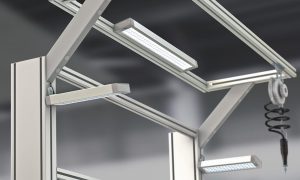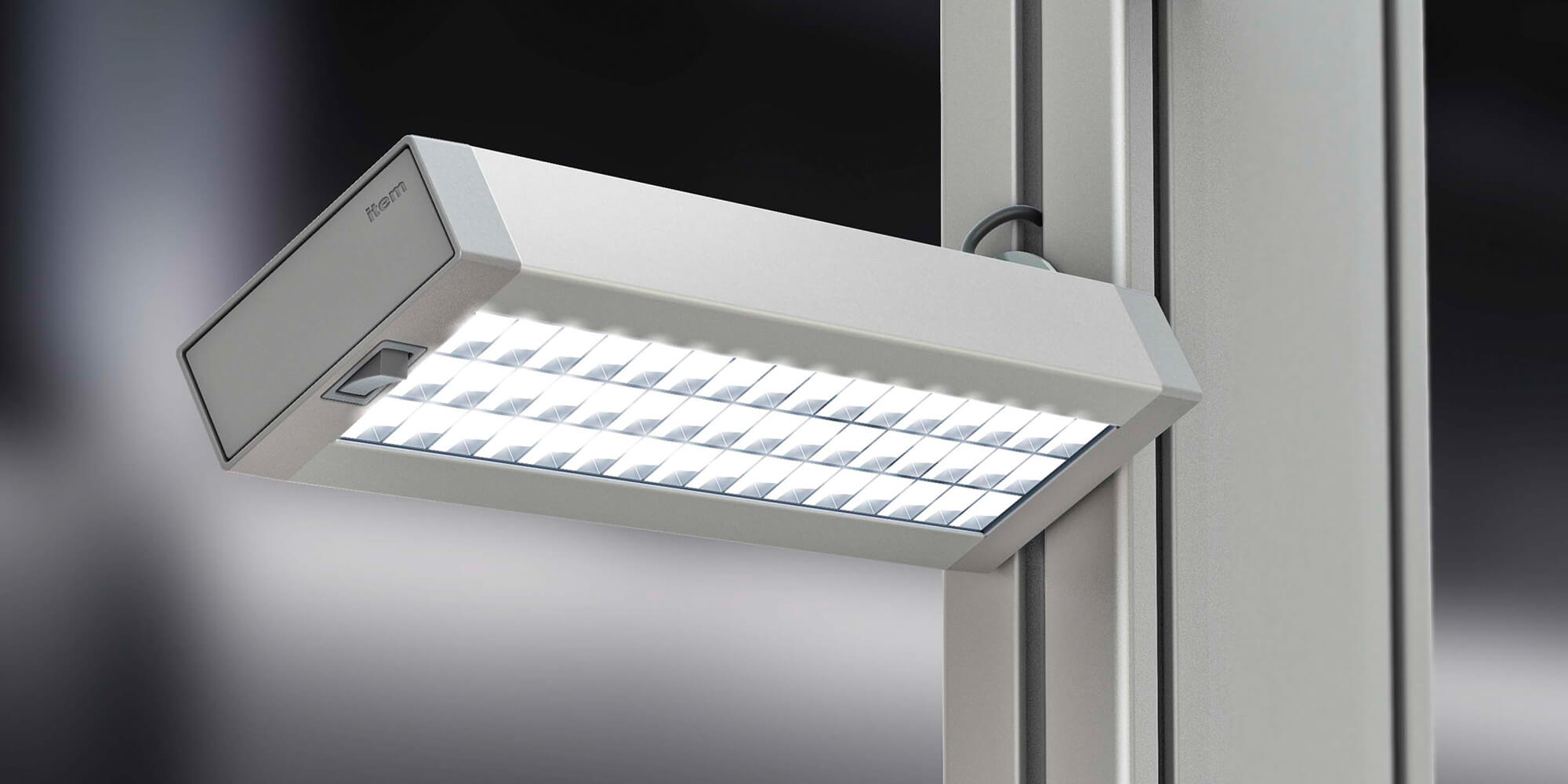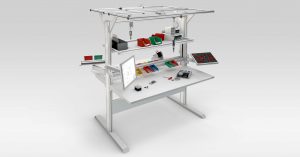Despite being highly relevant, the impact of work bench lighting on health and productivity is still underestimated.
Some aspects of ergonomics and work bench design in production are particularly obvious. Examples include height-adjustable work benches and chairs, a correct sitting position, and a customised handling area for supplying materials and tools. That makes it easy to quite literally lose sight of the role played by ergonomic work bench lighting. However, our free study “How ergonomically do companies work in manual production?” paints a multi-faceted picture. While just 55 percent of respondents who are already using an ergonomic work bench system said this included appropriate lighting solutions, for example, the survey also reveals that all respondents (including those who don’t yet make use of ergonomic solutions) regard lighting as the most important ergonomic factor of all. This demonstrates that people are aware of lighting’s significance, but other ergonomic measures appear to take precedence. Our blog post therefore offers basic tips relating to ergonomic lighting and aims to make workers more aware of this issue.

Ergonomics study for industry
This study shows which ergonomic measures are already being used in manual production. Find out more and see how you compare – how much progress has your company made?
GET YOUR COPY NOW
Why is ergonomic work bench lighting important?
Light not only has a direct influence on workers’ eyes and eyesight. Amongst other things, it also affects their autonomic nervous system, which automatically regulates their heartbeat, blood pressure and breathing, for instance. Lighting similar to daylight, for example, fosters alertness, attentiveness and a sense of wellbeing. What’s more, optimising work bench lighting in line with ergonomic principles goes far beyond asking whether there is enough light. Situation-appropriate lighting must be adapted precisely to the specific circumstances (more on that shortly). Failing to do so causes concentration problems, headaches and symptoms of fatigue. For example, a Swiss psychological study ascertained that less effort was required to complete a cognitive task at a higher colour temperature of 6500 K (K = Kelvin). The effects of a lower colour temperature (2800 K), on the other hand, even included increased pressure on participants’ cardiovascular system.
The ideal combination of taking responsibility for the workforce’s health and wellbeing and optimising processes creates a real win-win situation.
The researchers also concluded that lighting directly affects motivation and performance. Accordingly, it has a direct bearing on companies’ profitability. As with all other aspects of work bench ergonomics, the ideal combination of taking responsibility for the workforce’s health and wellbeing and optimising processes creates a real win-win situation. In this scenario, optimised lighting also improves quality thanks to an enhanced perception of details and colours when working.
Optimum lighting at manual assembly work benches
When it comes to good lighting at manual work benches, there are a number of aspects to consider – a customised lighting level, illuminating specific areas, the appropriate colour temperature, even and glare-free lighting, and avoiding reflections. The physical unit of measurement used for the level of lighting (illuminance) is the lux (lx), with 1 lux being roughly equivalent to the light provided by a candle located one metre away. The recommended level of lighting for manual assembly work is as follows:
- Basic assembly work: 200 lx
- Medium-precision assembly work: 300 lx
- Intricate assembly work: 500 lx
- High-precision assembly work: 750 lx
- Precision and micro mechanics: 1000-1500 lx
Specific areas of the work bench can be lit precisely using flexibly adjustable LED spotlights. Cutting-edge LED technology is, in any case, the industry standard. Spotlight 6W LED 10° from item, for example, achieves an illuminance of up to 20,000 lx at a distance of 500 mm. It can also be dimmed as required using a dimmer switch on the housing, the selected setting being retained when the light is switched off and back on again. The colour temperature of 4000 K is ideal. That brings us back to a topic we touched on earlier. A colour temperature of 4000 K has proved appropriate for manual assembly work. This is also called “neutral white” and has a stimulating effect that boosts concentration. It offers good colour rendering and contrast perception, too. A level of 4000 K is midway between the warm white light of a light bulb (2000-2700 K) and daylight white (over 5300 K).

Avoiding glare and other distractions when working
Having to look directly into the light or being distracted in some other way when you are working quickly makes you lose concentration. Appropriate components and precise positioning are both required to avoid this. High-quality LED lights such as the ones supplied by item have a parabolic reflector grid, a microprism cover and an adjustable fastener, thereby ensuring even, glare-free lighting at the work bench. Generally speaking, the light should be positioned so that it brightly illuminates the work area without shining in workers’ eyes. Otherwise, their eyes have to adjust to the new situation each time they encounter the strong glare. The avoidable stress this creates costs valuable time and makes accidents more likely. Besides direct glare, the kind of indirect glare caused, for example, by reflective surfaces or workpieces at the work bench should also be avoided.
The homogeneous light of high-quality LED lights significantly reduces the strain on workers’ eyes.
High-quality LED lighting is also a proven means of preventing multiple overlapping shadows. These occur, for instance, when using individual spotlights – each light diode produces a hard shadow that puts great strain on the eyes. When carrying out intricate work, multiple shadows around the hands in particular are irritating and increase the error rate. The homogeneous light of high-quality LED lights significantly reduces the strain on workers’ eyes. Flicker-free light is also a vitally important part of ergonomic lighting. Even low-frequency flickering that we aren’t consciously aware of causes stress in the human body. This expresses itself in the form of reactions such as headaches, nausea and fatigue.
Further ergonomics tips for assembly work benches
Following our little tour through the world of work bench lighting, light colour, lux and lights, would you like to find out more about ergonomics? Since its early days, the item blog has included regular posts with tips for ergonomic work bench design. Although these have mainly focused on manual production work benches, many of the recommendations are also relevant to office work. These include basic ergonomic principles, special exercises for workers and the ideal ratio of sitting to standing. Here is a selection of posts:
- Overview of work bench design in production
- Why an ergonomic assembly work bench is a must
- How ergonomics boosts the efficiency of industrial work benches
- The 9 most commonly used ergonomic solutions in manual production
- Ergonomics illustration – how to sit correctly!
- Instant tips to keep fit@work with item
- Ergonomic sitting at industrial work benches
- LED industrial lights: Getting the best possible view of your working environment
Would you like to keep up-to-date with developments relating to ergonomics? Then we have something that’s right up your street! Simply subscribe to the item blog by completing the box at the top right.





